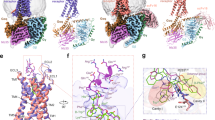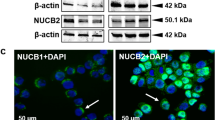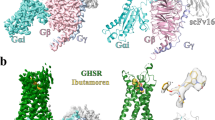Abstract
Small synthetic molecules called growth-hormone secretagogues (GHSs)1,2,3 stimulate the release of growth hormone (GH) from the pituitary4,5. They act through GHS-R, a G-protein-coupled receptor for which the ligand is unknown. Recent cloning of GHS-R6,7 strongly suggests that an endogenous ligand for the receptor does exist and that there is a mechanism for regulating GH release that is distinct from its regulation by hypothalamic growth-hormone-releasing hormone (GHRH)4,5. We now report the purification and identification in rat stomach of an endogenous ligand specific for GHS-R. The purified ligand is a peptide of 28 amino acids, in which the serine 3 residue is n-octanoylated. The acylated peptide specifically releases GH both in vivo and in vitro, and O-n-octanoylation at serine 3 is essential for the activity. We designate the GH-releasing peptide ‘ghrelin’ (ghre is the Proto-Indo-European root of the word ‘grow’). Human ghrelin is homologous to rat ghrelin apart from two amino acids. The occurrence of ghrelin in both rat and human indicates that GH release from the pituitary may be regulated not only by hypothalamic GHRH, but also by ghrelin.
This is a preview of subscription content, access via your institution
Access options
Subscribe to this journal
Receive 51 print issues and online access
$199.00 per year
only $3.90 per issue
Buy this article
- Purchase on Springer Link
- Instant access to full article PDF
Prices may be subject to local taxes which are calculated during checkout






Similar content being viewed by others
References
Bowers,C. Y. Growth hormone-releasing peptide (GHRP). Cell. Mol. Life Sci. 54, 1316–1329 (1998).
Smith,R. G. et al. Peptidomimetic regulation of growth hormone secretion. Endocrine Rev. 18, 621–645 (1997).
Smith,R. G. et al. A nonpeptidyl growth hormone secretagogue. Science 260, 1640–1643 (1993).
Akman,M. S., Girard,M., O'brien,L. F., Ho,A. K. & Chik,C. L. Mechanisms of action of a second generation growth hormone-releasing peptide (Ala-His-D-βNal-Ala-Trp-D-Phe-Lys-NH2) in rat anterior pituitary cells. Endocrinology 132, 1286–1291 (1993).
Cheng,K., Chan,W. W. S., Barreto,A., Convey,E. M. & Smith,R. G. The synergistic effects of His-D-Trp-Ala-Trp-D-Phe-Lys-NH2 on growth hormone (GH)-releasing factor-stimulated GH release and intracellular adenosine 3′,5′-monophosphate accumulation in rat primary pituitary cell culture. Endocrinology 124, 2791–2798 (1989).
Howard,A. D. et al. A receptor in pituitary and hypothalamus that functions in growth hormone release. Science 273, 974–977 (1996).
McKee,K. K. et al. Molecular analysis of rat pituitary and hypothalamic growth hormone secretagogue receptors. Mol. Endocrinol. 11, 415–423 (1997).
Civelli,O. Functional genomics: the search for novel neurotransmitters and neuropeptides. FEBS Lett. 430, 55–58 (1998).
Meunier,J. C. et al. Isolation and structure of the endogenous agonist of opioid receptor-like ORL1 receptor. Nature 377, 532–535 (1995).
Reinscheid,R. K. et al. Orphanin FQ: a neuropeptide that activates an opioidlike G protein-coupled receptor. Science 270, 792–794 (1995).
Sakurai,T. et al. Orexins and orexin receptors: a family of hypothalamic neuropeptides and G protein-coupled receptors that regulate feeding behavior. Cell 92, 573–585 (1998).
Hinuma,S. et al. A prolactin-releasing peptide in the brain. Nature 393, 272–276 (1998).
Sudoh,T., Kangawa,K., Minamino,N. & Matsuo,H. A new natriuretic peptide in porcine brain. Nature 332, 78–81 (1988).
Kitamura,K. et al. Adrenomedullin: a novel hypotensive peptide isolated from human pheochromocytoma. Biochem. Biophys. Res. Commun. 192, 553–560 (1993).
Kozak,M. Point mutations define a sequence flanking the AUG initiator codon that modulates translation by eukaryotic ribosomes. Cell 44, 283–292 (1986).
Heijne,V. G. A new method for predicting signal sequence cleavage sites. Nucleic Acids Res. 14. 4683–4690 (1986).
Nakayama,K. Furin: a mammalian subtilisin/Kex2p-like endoprotease involved in processing of a wide variety of precursor proteins. Biochem. J. 327, 625–635 (1997).
Kojima,M. et al. Cloning and characterization of a novel natriuretic peptide in frog (Rana catesbeiana). J. Biol. Chem. 269, 13136–13140 (1994).
Alonso,G. Effects of colchicine on the intraneuronal transport of secretory material prior to the axon: a morphofunctional study in hypothalamic neurosecretory neurons of the rat. Brain Res. 453, 191–203 (1988).
Guan,X. M. et al. Distribution of mRNA encoding the growth hormone secretagogue receptor in brain and peripheral tissues. Mol. Brain Res. 48, 23–29 (1997).
Bisi,G. et al. Acute cardiovascular and hormonal effects of GH and hexarelin, a synthetic GH-releasing peptide, in humans. J. Endocrinol. Invest. 22, 266–272 (1999).
Berghe,G. V. et al. Reactivation of pituitary hormone release and metabolic improvement by infusion of growth hormone-releasing peptide and thyrotropin-releasing hormone in patients with protracted critical illness. J. Clin. Endocrinol. Metab. 84, 1311–1323 (1999).
Schroeder,K. S. & Neagle,B. D. FLIPR: a new instrument for accurate, high throughput optical screening. J. Biomol. Screening 1, 75–80 (1996).
Coward,P. et al. Controlling signaling with a specifically designed Gi-coupled receptor. Proc. Natl Acad. Sci. USA 95, 352–357 (1998).
Jonathan,N. B., Peleg,E. & Hoefer,M. T. Optimization of culture conditions for short-term pituitary cell culture. Methods Enzymol. 103, 249–257(1983).
Date,Y. et al. Orexin, orexigenic hypothalamic peptides, interact with autonomic, neuroendocrine and neuroregulatory systems. Proc. Natl Acad. Sci. USA 96, 748–753 (1999).
Date,Y. et al. Enterochromaffin-like cells, a cellular source of uroguanylin in rat stomach. Endocrinology 140, 2398–2404 (1999).
Acknowledgements
We thank R. Haruno for technical assistance; H. Kaiya and T. Maki for technical advice; and R. J. Adams for comments on the manuscript. This work was supported in part by Special Coordination Funds for Promoting Science and Technology from the Science and Technology Agency (Encouragement System of COE) (to H.M.), and a grant-in-aid for the Promotion of Fundamental Studies in Health Science from the Organization for Pharmaceutical Safety and Research of Japan (to K.K.).
Author information
Authors and Affiliations
Corresponding author
Rights and permissions
About this article
Cite this article
Kojima, M., Hosoda, H., Date, Y. et al. Ghrelin is a growth-hormone-releasing acylated peptide from stomach. Nature 402, 656–660 (1999). https://doi.org/10.1038/45230
Received:
Accepted:
Issue Date:
DOI: https://doi.org/10.1038/45230
This article is cited by
-
The intersection between ghrelin, metabolism and circadian rhythms
Nature Reviews Endocrinology (2024)
-
Pre-prandial plasma liver-expressed antimicrobial peptide 2 (LEAP2) concentration in humans is inversely associated with hunger sensation in a ghrelin independent manner
European Journal of Nutrition (2024)
-
Complementary role of peripheral and central autonomic nervous system on insulin-like growth factor-1 activation to prevent fatty liver disease
Hepatology International (2024)
-
Insights on discovery, efficacy, safety and clinical applications of ghrelin receptor agonist capromorelin in veterinary medicine
Veterinary Research Communications (2024)
-
Roles of ghrelin, hepcidin and HIF-2α in iron metabolism in iron deficiency anemia
Irish Journal of Medical Science (1971 -) (2024)
Comments
By submitting a comment you agree to abide by our Terms and Community Guidelines. If you find something abusive or that does not comply with our terms or guidelines please flag it as inappropriate.



